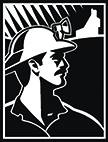
HOW HARMFUL are STAMP SANDS?
Mine tailings are common at historic mine sites in North America. Depending upon their metal content, they can be harmful to the environment’s organisms, including humans.
The Keweenaw’s stamp sands contain toxic heavy metals, predominantly copper. Gay’s stamp sands contain around 0.3% copper. At 0.8% copper, they would be marketable for the copper content. Other metals in the Gay sands include aluminum, arsenic, chromium, cobalt, manganese, nickel, lead, silver and zinc - all at levels that exceed Michigan safety water quality standards.
At high levels, copper-laden stamp sands can be harmful to humans. Because stamp sands are basalt, their fine dust is a silicate, which when inhaled over time causes silicosis. In other parts of the Keweenaw, the Environmental Protection Agency (EPA) has covered the stamp sands as part of the federal Superfund Program to clean contaminated land. Stamp sands along Torch Lake and some interior rivers are covered with topsoil and vegetation to contain wind-blown sand and prevent inhalation. Copper in stamp sands can also make drinking water non-potable. Thus, residents are recommended not to dig shallow wells in the stamp sands, nor drink water from wells or pools. At Gay, blowing dust from the uncovered sands could be harmful over a period of long and regular exposure to human lungs. In the 1980s when the EPA determined the boundaries for the Torch Lake Superfund site, they did not include the Gay sands. The Keweenaw County Road Commission acquired the sands and utilizes them for roads and construction.
At Gay and in Big Traverse Bay the predominant threat is to the environment - especially to small organisims and to fish. Stamp sands from copper mining continue to migrate and cover lake- and river-bed sediments, e.g. Buffalo Reef, and the shoreline and its wetlands. More sands create higher copper concentrations, which means the environment becomes more toxic.
Fairly low levels of copper are toxic to fish, amphibians, some wetlands plants, and to the small organisms vital to aquatic food systems. The Great Lakes Indian Fish & Wildlife Commission (GLIFWC) recently documented eight species of fish affected by stamp sands. In this case, juvenile fish are relatively abundant in shallow waters in Big Traverse Bay where there are no stamp sands. But there is a virtual absence of juvenile fishes along the stamp sand beaches from the Gay sand pile southward to the Traverse River. Absence of food due to toxic stamp sands may be the reason.
The whole nearshore ecosystem is impacted by the loss of the smaller organisms that feed young fish. The economic and cultural impact to the Keweenaw Bay Indian Community and to commercial and recreational fishing is becoming significant as Gay’s stamp sands continue to cover Buffalo Reef. Currently 25 - 25% of the reef is already covered. If nothing is done to remedy this, 60% of the reef will be covered by 2025.
High amounts of stamp sands underwater correlate with higher copper concentrations. The highest concentration of stamp sands to pure natural sands in Big Traverse Bay are closest to the shore line. The contours of high copper concentrations embedded in the sands resemble those in this map. Highest levels of copper are found nearshore from Gay to Traverse River. They decrease along the outer edges of Buffalo Reef and Big Traverse Bay. At 50% coverage of the reef with copper-laden stamp sands, living organisms decline dramatically to 30%. At 75% coverage, all lakebed organisms will disappear.
Fewer organisms near shore in Big Traverse Bay. Small organisms called macroinvertebrates form the basis of the food web in Big Traverse Bay. Scientists call them “benthic” (or lakebed) organisms and they are critical to the health of fish populations in the bay. Note the difference between the healthier outer edges (dark green) of the bay and their decreasing absence as you get closer to the shore (light green). Most of Buffalo Reef has nearly one-half to one-quarter the number of macroinvertebrates needed for a healthy system.
Using small organisms to register the health of Lake Superior
The diporeia is one of the most important small organisms in Lake Superior, labeled an “indicator species” used to track the health of the lake. It looks like a shrimp, but it actually evolved from a marine organism trapped in our northern lakes during the ice age. The EPA office in Duluth has found that stamp sands in Gay and the Big Traverse Bay are lethal to several macroinvertebrates such as midges, blackworms, water flea, and diporeia. The death of any one of these species can severely impact the broader ecosystem. The primary stamp sand toxin was copper.



